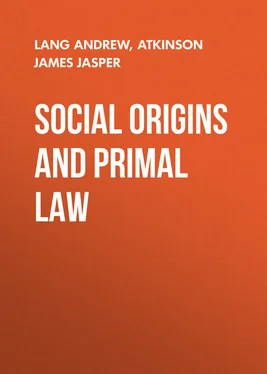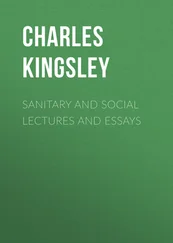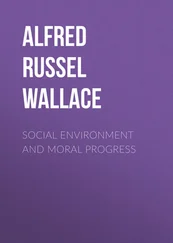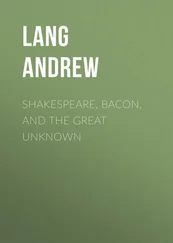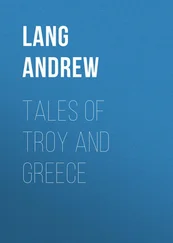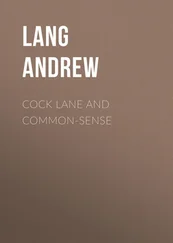Andrew Lang - Social Origins and Primal Law
Здесь есть возможность читать онлайн «Andrew Lang - Social Origins and Primal Law» — ознакомительный отрывок электронной книги совершенно бесплатно, а после прочтения отрывка купить полную версию. В некоторых случаях можно слушать аудио, скачать через торрент в формате fb2 и присутствует краткое содержание. Жанр: foreign_antique, foreign_prose, на английском языке. Описание произведения, (предисловие) а так же отзывы посетителей доступны на портале библиотеки ЛибКат.
- Название:Social Origins and Primal Law
- Автор:
- Жанр:
- Год:неизвестен
- ISBN:нет данных
- Рейтинг книги:3 / 5. Голосов: 1
-
Избранное:Добавить в избранное
- Отзывы:
-
Ваша оценка:
- 60
- 1
- 2
- 3
- 4
- 5
Social Origins and Primal Law: краткое содержание, описание и аннотация
Предлагаем к чтению аннотацию, описание, краткое содержание или предисловие (зависит от того, что написал сам автор книги «Social Origins and Primal Law»). Если вы не нашли необходимую информацию о книге — напишите в комментариях, мы постараемся отыскать её.
Social Origins and Primal Law — читать онлайн ознакомительный отрывок
Ниже представлен текст книги, разбитый по страницам. Система сохранения места последней прочитанной страницы, позволяет с удобством читать онлайн бесплатно книгу «Social Origins and Primal Law», без необходимости каждый раз заново искать на чём Вы остановились. Поставьте закладку, и сможете в любой момент перейти на страницу, на которой закончили чтение.
Интервал:
Закладка:
THE CLASS SYSTEM IN AUSTRALIA
Though the existence of what are called exogamous 'phratries' (two to each tribe) was made known, as regards the North American tribes, by Mr. Lewis Morgan (to whose work we return) in the middle of the nineteenth century, almost our earliest hint of its existence in Australia came from the Rev. W. Ridley, a learned missionary, in 1853-55. In Mr. McLennan's Studies in Ancient History 62 62 Second series, pp. 289-310.
will be found an account of Mr. Ridley's facts, as they gradually swelled in volume, altered in character, and were added to, and critically constructed, by the Rev. Mr. Fison, and Mr. A. W. Howitt. These gentlemen were regarded by Mr. McLennan as the allies of Mr. Morgan, in a controversy then being waged with some acerbity. He, therefore, criticised the evidence from Australia rather keenly. It is probable that Mr. Morgan and Mr. McLennan both had some right on their parts – seeing each a different side of the shield – though a few points in the discussion are still undecided. But it seems certain that the continued researches of Messrs. Fison and Howitt, reinforced by the studies of Messrs. Spencer and Gillen in Central Australia, have invalidated some of Mr. McLennan's opinions as to matters of fact.
Much trouble and confusion will be saved if we remember that, as has been said, under the 'classificatory system,' three sets of rules applying to marriage exist. The totem rule exists, rules as to marriage in relation to generations and so-called degrees of kindred (real or 'tribal') exist ('classes'), and, thirdly, there are the rules relative to 'phratries,' the phratries, being, I think, in origin themselves totemic. We shall mainly consider here the so-called 'bisection' of a tribe into two exogamous and intermarrying 'phratries,' while remembering Herr Cunow's opinion that a 'class' is one thing, a 'phratry' quite another. 63 63 I shall, for my own part, use 'phratry' for the two 'primary exogamous divisions' of a tribe, and 'class' for the divisions within the 'phratry' which do not appear to be of totemic origin. Mr. Fison applies 'class' to both the primary divisions and those contained in each of them, observing that 'the Greek "phratria" would be the most correct term.' He is aware, of course, that this employment of phratria is arbitrary, but it is convenient. While he applies 'class' both to 'the primary divisions of a community, and their first subdivisions,' to the latter I restrict 'classes,' using phratry for the former ( Kamilaroi and Kurnai , p. 24).
THE VARIETIES OF MARRIAGE DIVISIONS IN AUSTRALIA
Perhaps the most recent, lucid, and well-informed writer on the various divisions which regulate the marriages of the Australian tribes is Mr. R. H. Mathews. 64 64 Jour. and Proc. of the Roy. Soc. N.S.W. , xxviii, xxxii, xxxiv.
In some regions, the system of two intermarrying phratries exists, without further subdivision (except in regard to totem kins). Sometimes each phratry is divided into two 'sections' (or 'classes'), making four for the tribe. Again, each phratry may have four 'subsections' or 'classes,' making eight for the tribe. Each phratry, like each 'class,' 'has an independent name by which its members are easily recognised.'
Obviously we need, of all tilings, to know the actual meanings of these names, but we do not usually know them. As we shall see, where a tribe has two 'phratries' and no subordinate 'classes,' the names of these 'phratries,' when they can be translated, are usually names of animals. In a few cases, as will later appear, when there are 'classes' under and in the 'phratries' their names seem to indicate distinctions of 'old' and 'young.' But Mr. Mathews nowhere, as far as I have studied him, gives the meanings of the 'class' names, some of which are of recent adoption. Mr. Mathews usually gives only 'Phratry A' and 'Phratry B.' We now cite his tables of the simple 'phratry' system, of the 'phratry' plus two classes system, and of the 'phratry' plus four classes system; making four, or eight, such divisions for the tribe.
'In describing the social structure of a native Australian community, the first matter calling for attention is the classification of the people into two primary divisions, called phratries, or groups – the men of each phratry intermarrying with the women of the opposite one, in accordance with prescribed laws.'
Mr. Mathews then mentions that some tribes have (1) this simple division only (of course, as a rule, plus totem kins). (2) Elsewhere each phratry is composed of two 'sections' (called by us 'classes'). (3) Elsewhere, again, each phratry has four sections (we need not discuss here the tribes where none of these things exist).
Mr. Mathews now gives tables representing the working of the system in each of the three cases. 65 65 Proc. Roy. Soc. N.S.W. xxxiv. 120-122.
1

2
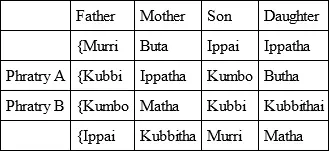
3
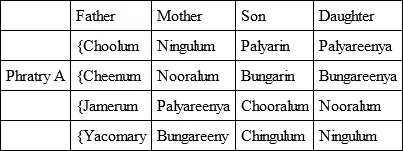
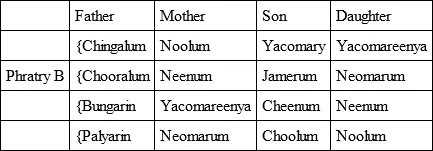
It will be seen that, under the simple phratry system, children of the female Matturrin are always Matturri and Matturrin, children of the female Kirrarooan are always Kirraroo and Kirrarooan. On the phratry plus two classes system, female Butha is mother of Ippatha and Ippatha of Butha for ever. On the phratry plus four classes system, female Ningulum has a Palyareena daughter, who has a Nooralum daughter, who has a Bungareenya daughter, whose daughter reverts to the original Ningulum class, and so on, ad infinitum . The women remain constant to their 'phratry,' and marry always the men of the opposite phratry.
It is to be observed that, by customary law, brothers and sisters actual (and not 'tribal') may never intermarry. 66 66 Prov. Jour. Roy. Soc. N.S.W. , xxxiv. 127. Mr. Fison makes an exception for some Kamilaroi.
In short, consanguinity is now fully understood by the natives, and too close unions are forbidden on the ground of consanguinity. It also seems that, though the blacks are all on the same level of material culture, yet reflection on marriage rules, and modification of these rules by additional restrictions and alterations, have been carried much further by some tribes than by others. I by no means deny, but rather affirm, that consanguinity is now understood, and that rules have in some tribes been consciously made, and altered, to avoid certain marriages as of 'too near flesh.' But I do not think that, at the beginning, the objection to consanguineous marriages, as such , can have been entertained, and I am not of opinion that, for the purpose of preventing such marriages, in the beginning, a horde was bisected into two phratries, and each phratry split up into totem groups. Rather, I conceive, certain primitive conditions of life led to the evolution of certain rules, independent of any theory about the noxiousness or immorality of marriages of near kin; and then reflection on those primal rules helped to beget moral ideas, and improvements on the rules themselves. In the original restrictions, morality, in our sense, was only implicitly or potentially present, though now it has risen into explicit consciousness. The tribes came to think certain marriages morally wrong, or physically noxious, because they were forbidden; such unions were not, in the first instance, forbidden because they were deemed physically injurious, or morally wrong. These ideas have, by this time, been evolved; but it does not follow that they were present at the beginning.
Интервал:
Закладка:
Похожие книги на «Social Origins and Primal Law»
Представляем Вашему вниманию похожие книги на «Social Origins and Primal Law» списком для выбора. Мы отобрали схожую по названию и смыслу литературу в надежде предоставить читателям больше вариантов отыскать новые, интересные, ещё непрочитанные произведения.
Обсуждение, отзывы о книге «Social Origins and Primal Law» и просто собственные мнения читателей. Оставьте ваши комментарии, напишите, что Вы думаете о произведении, его смысле или главных героях. Укажите что конкретно понравилось, а что нет, и почему Вы так считаете.
